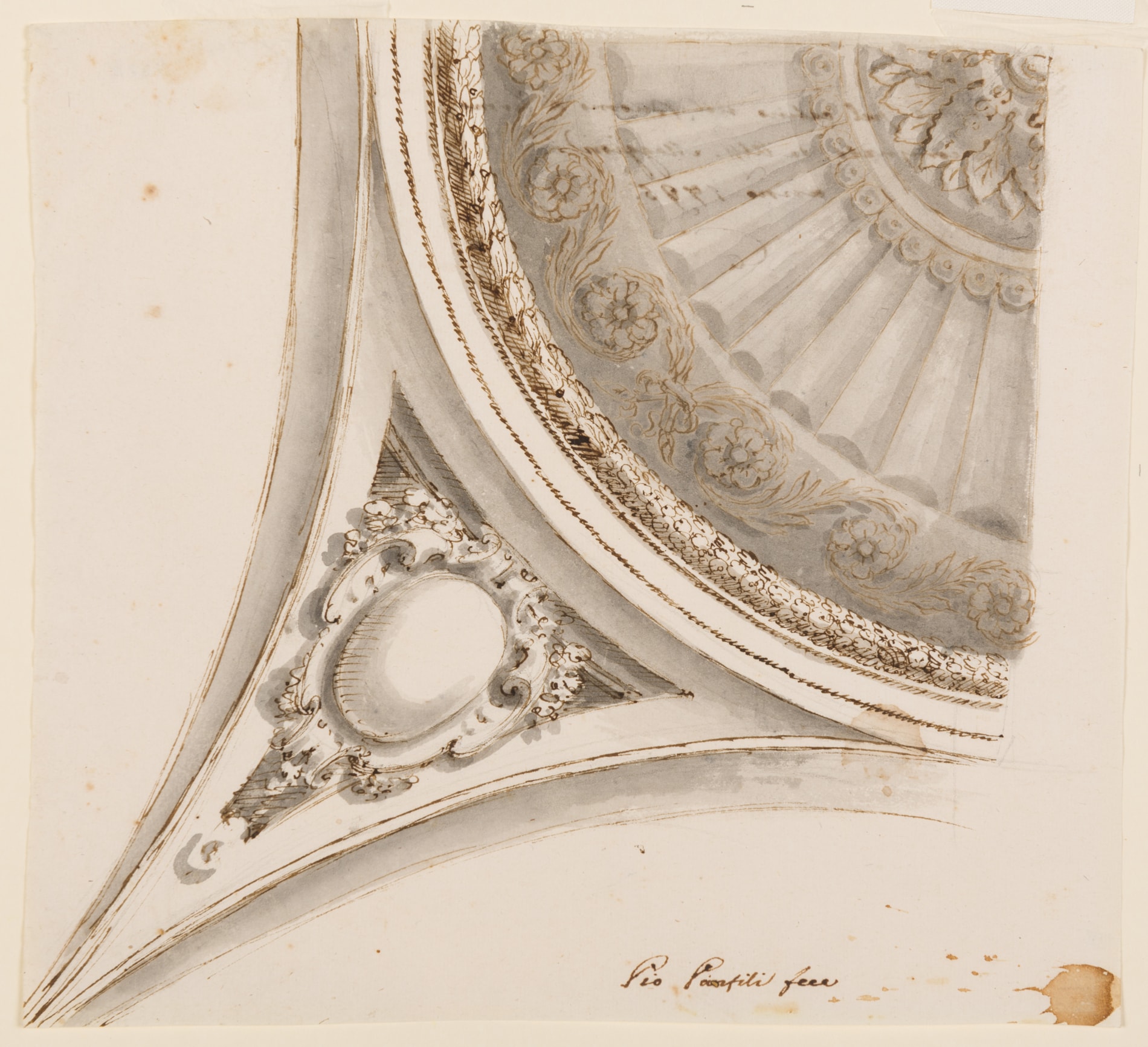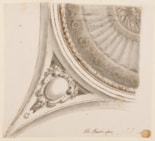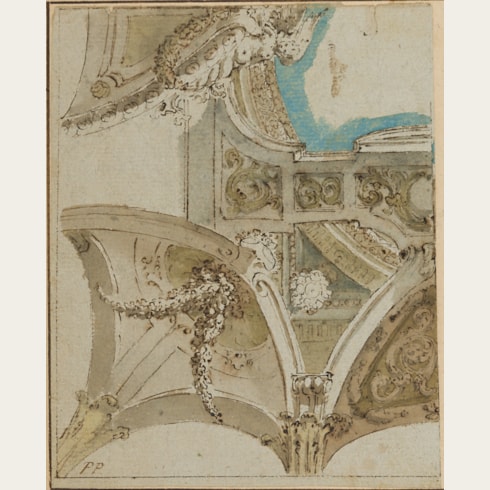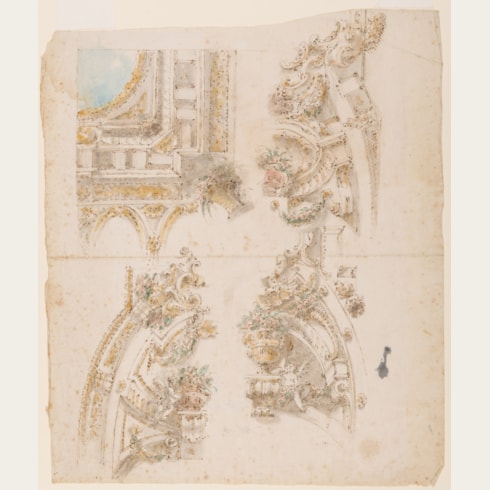Pio PANFILI
(Porto San Giorgio 1723 - Bologna 1812)
Design for a Corner Pendentive and Part of a Dome
Pen and brown ink and grey wash, over traces of an underdrawing in pencil.
Signed or inscribed Pio Panfili fece at the lower right centre.
Inscribed Schizzo pel cabino nel Duomo di Fermo / comparato da Aless. Maggiori / anno 1795 on the verso.
208 x 228 mm. (8 1/8 x 9 in.)
Signed or inscribed Pio Panfili fece at the lower right centre.
Inscribed Schizzo pel cabino nel Duomo di Fermo / comparato da Aless. Maggiori / anno 1795 on the verso.
208 x 228 mm. (8 1/8 x 9 in.)
The present sheet, as the inscription on the verso suggests, would appear to be a preparatory study for part of Pio Panifili's illusionistic ceiling decoration of the Duomo at Fermo, executed between 1787 and 1788, when the interior of the church was renovated in a neoclassical style under the auspices of the architect Cosimo Morelli. Panfili decorated the vault of the nave with three fictive domes, divided by fluted pilasters with stucco capitals.
As the illusionistic scheme of the three painted domes has been described, ‘Starting with the entrance, only the first two have the same perspective characteristics. Having a square ceiling with rounded corners to connect with the intersections of the main arches, [Panfili] made use of special shadow effects and dosed the perspective proportions of the ornamental elements (cornice, finials, false stuccoes, etc.), succeeding in simulating a perfect curvature only for the observer placed exactly in the centre, while, for those looking from the side, the circumference of the dome does not appear ellipsoidal, but flattened in several places…The three faux domes are decorated in a sunburst pattern, with plant-like volutes and faux stuccoes; in the pendentives, inside oval medallions subtended by two branches with long leaves held by ribbons, are biblical symbols alluding to the Virgin Mary…The rendering of the three-nave interior, with rounded arches and the succession of sub-arches and domes, clearly reveals [Panfili’s] scenographic taste. All the decoration is carried out with extreme rationality and balance, in order to achieve a perfect overall effect, taking care not so much of the appearance of the individual parts, but of their fusion with the architecture: painting, sculpture, marble and stucco ornaments blend with the architecture so as to achieve a single vision and a single conception, responding perfectly to the spiritual needs of the Duomo.’
A stylistically comparable, signed drawing of a ceiling design by Panfili, like the present sheet once in the collection of Alessandro Maggiori, was until recently in the Lodewijk Houthakker collection. Another drawing by Panfili for a cartouche in one of the pendentives of the Duomo in Fermo, again formerly in the Maggiori collection, is today in the Museo Civico d’Arte Industriale e Galleria Davia Bargellini in Bologna.
The lawyer and nobleman Count Alessandro Maggiori (1764-1834) assembled one of the most interesting and varied collections of Italian drawings formed in the late 18th and early 19th century. He began collecting drawings while living and working in Bologna, and continued to do so after he settled in Rome in 1798. Maggiori later moved to Fermo, and in his retirement lived at the Villa Il Castellano in the nearby coastal town of Porto Sant’Elpidio, where his collection of 16th, 17th and 18th century Italian drawings was kept.
According to the notes that he added on the sheets he acquired, Maggiori seems to have bought most of his drawings in Faenza, Bologna, Naples and Rome between 1785 and 1810. At his death in 1834, the collection of nearly three thousand drawings was dispersed by Maggiori’s heirs. A group of 150 drawings from the collection was acquired in 1925 by the municipality of the Marchigian town of Monte San Giusto and today forms the nucleus of the Centro Alessandro Maggiori there. Drawings from the Maggiori collection are today to be found in most major museums, including the British Museum, the Louvre and the Metropolitan Museum of Art.
As the illusionistic scheme of the three painted domes has been described, ‘Starting with the entrance, only the first two have the same perspective characteristics. Having a square ceiling with rounded corners to connect with the intersections of the main arches, [Panfili] made use of special shadow effects and dosed the perspective proportions of the ornamental elements (cornice, finials, false stuccoes, etc.), succeeding in simulating a perfect curvature only for the observer placed exactly in the centre, while, for those looking from the side, the circumference of the dome does not appear ellipsoidal, but flattened in several places…The three faux domes are decorated in a sunburst pattern, with plant-like volutes and faux stuccoes; in the pendentives, inside oval medallions subtended by two branches with long leaves held by ribbons, are biblical symbols alluding to the Virgin Mary…The rendering of the three-nave interior, with rounded arches and the succession of sub-arches and domes, clearly reveals [Panfili’s] scenographic taste. All the decoration is carried out with extreme rationality and balance, in order to achieve a perfect overall effect, taking care not so much of the appearance of the individual parts, but of their fusion with the architecture: painting, sculpture, marble and stucco ornaments blend with the architecture so as to achieve a single vision and a single conception, responding perfectly to the spiritual needs of the Duomo.’
A stylistically comparable, signed drawing of a ceiling design by Panfili, like the present sheet once in the collection of Alessandro Maggiori, was until recently in the Lodewijk Houthakker collection. Another drawing by Panfili for a cartouche in one of the pendentives of the Duomo in Fermo, again formerly in the Maggiori collection, is today in the Museo Civico d’Arte Industriale e Galleria Davia Bargellini in Bologna.
The lawyer and nobleman Count Alessandro Maggiori (1764-1834) assembled one of the most interesting and varied collections of Italian drawings formed in the late 18th and early 19th century. He began collecting drawings while living and working in Bologna, and continued to do so after he settled in Rome in 1798. Maggiori later moved to Fermo, and in his retirement lived at the Villa Il Castellano in the nearby coastal town of Porto Sant’Elpidio, where his collection of 16th, 17th and 18th century Italian drawings was kept.
According to the notes that he added on the sheets he acquired, Maggiori seems to have bought most of his drawings in Faenza, Bologna, Naples and Rome between 1785 and 1810. At his death in 1834, the collection of nearly three thousand drawings was dispersed by Maggiori’s heirs. A group of 150 drawings from the collection was acquired in 1925 by the municipality of the Marchigian town of Monte San Giusto and today forms the nucleus of the Centro Alessandro Maggiori there. Drawings from the Maggiori collection are today to be found in most major museums, including the British Museum, the Louvre and the Metropolitan Museum of Art.
Born near Fermo in the Marches and active mainly in Bologna, Pio Bernardino Panfili studied at the Accademia Clementina in Bologna and established a successful career as a painter of ornament and perspectival decorations, and was also a prolific printmaker and an occasional set designer. He received one of his first important commissions when he was tasked with the fresco decoration of the ceiling vault of the Sala dell’Aquila in the Palazzo dei Priori in Fermo, executed between 1760 and 1762. Panfili had settled in Bologna by 1767, where he produced a series of large-scale engravings of urban views of the city, as well as numerous smaller city views published between 1770 and 1800. In 1774 he completed the ceiling decoration of the staircase of the Palazzo Comunale in Montegiorgio, and in 1783 published a series of ornamental prints under the title Frammenti d’ornati per li giovani principianti nel disegno. Elected a member of the Accademia Clementina in 1786, the following year Panfili began work on the illusionistic fresco decoration of the ceiling of the Duomo in Fermo, which was completed in 1788. At around the same time he decorated the chapel and several rooms of the Palazzo Guerrieri in Fermo. He died in 1812, aged almost ninety. A posthumous biography of the artist, entitled Memoria della vita di Pio Panfilj, was published by the Marchese Antonio Amorini Bolognini in 1835.
Architectural drawings by Pio Panfili are today in the Pierpont Morgan Library and the Cooper-Hewitt National Design Museum in New York, the Istituto Centrale per la Grafica in Rome and in several public collections in Bologna; notably an album of drawings and designs (including a self-portrait) in the Pinacoteca Nazionale in Bologna. Panfili also assembled a fine personal collection of drawings, including examples by Agostino Mitelli and Mauro Tesi.
Architectural drawings by Pio Panfili are today in the Pierpont Morgan Library and the Cooper-Hewitt National Design Museum in New York, the Istituto Centrale per la Grafica in Rome and in several public collections in Bologna; notably an album of drawings and designs (including a self-portrait) in the Pinacoteca Nazionale in Bologna. Panfili also assembled a fine personal collection of drawings, including examples by Agostino Mitelli and Mauro Tesi.
Provenance
Acquired in Bologna in 1795 by Alessandro Maggiori, Faenza, Rome and Porto Sant’Elpidio (with his inscription [cf. Lugt 3005b] on the verso).






